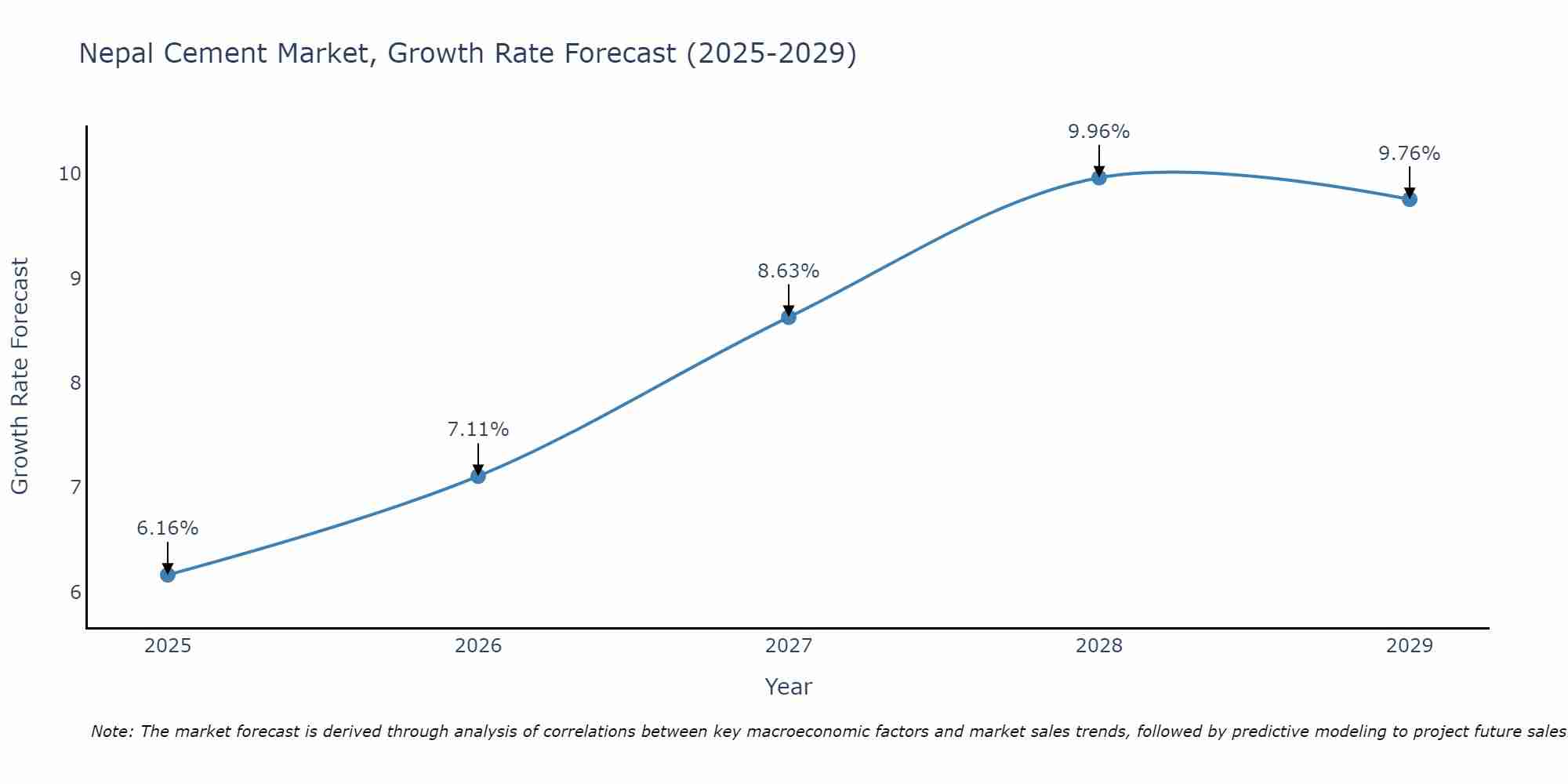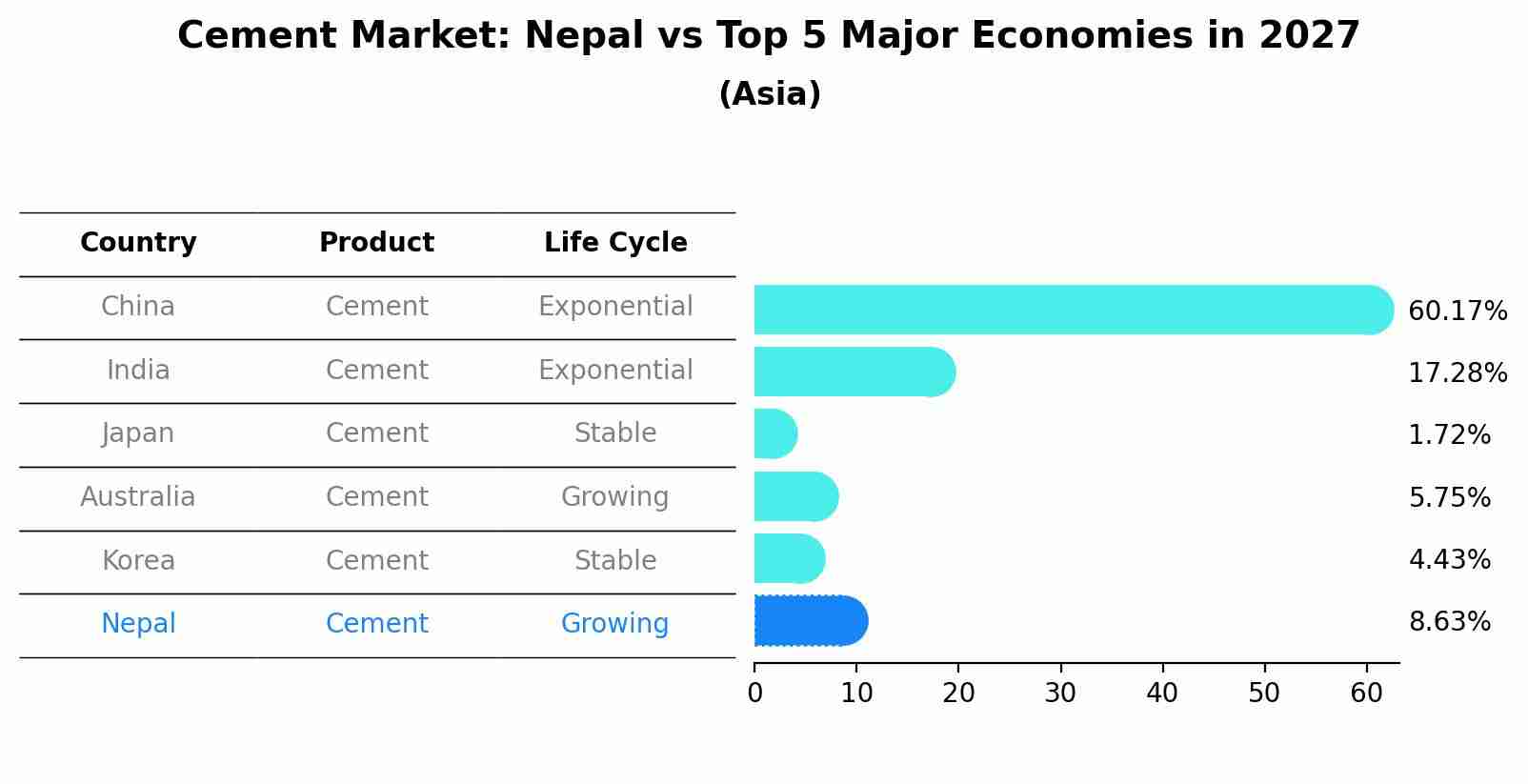Nepal Cement Market (2025-2031) | Analysis, Trends, Growth, Revenue, Size, Outlook, Share, Companies, Forecast, Industry & Value
| Product Code: ETC023276 | Publication Date: Oct 2020 | Updated Date: Jun 2025 | Product Type: Report | |
| Publisher: 6Wresearch | Author: Shubham Deep | No. of Pages: 70 | No. of Figures: 35 | No. of Tables: 5 |
Nepal Cement Market Size Growth Rate
The Nepal Cement Market is projected to witness mixed growth rate patterns during 2025 to 2029. Growth accelerates to 9.96% in 2028, following an initial rate of 6.16%, before easing to 9.76% at the end of the period.

Cement Market: Nepal vs Top 5 Major Economies in 2027 (Asia)
Nepal's Cement market is anticipated to experience a growing growth rate of 8.63% by 2027, reflecting trends observed in the largest economy China, followed by India, Japan, Australia and South Korea.

Nepal Cement Market Overview
The Nepal cement market is experiencing steady growth, driven by increasing construction activities in residential, commercial, and infrastructure sectors. The market is dominated by domestic manufacturers like Jagadamba Cement, Shalimar Cement, and others, with some presence of international brands like Dangote Cement. Factors such as government initiatives to boost infrastructure development, rising urbanization, and growth in real estate projects contribute to the market`s expansion. However, challenges like price fluctuations of raw materials, transportation costs, and regulatory hurdles impact the industry. Manufacturers are focusing on product innovation, quality improvement, and sustainable practices to stay competitive in the market. Overall, the Nepal cement market offers opportunities for growth, supported by the country`s development plans and increasing demand for construction materials.
Nepal Cement Market Trends
In the Nepal Cement Market, some of the current trends include the growing demand for high-quality and environmentally friendly cement products. There is a shift towards using sustainable materials in construction, leading to an increased interest in eco-friendly cement options. Additionally, innovation in cement manufacturing processes to reduce carbon emissions is becoming more prevalent. The market is also witnessing a trend towards digitalization and automation in production processes to improve efficiency and productivity. Furthermore, there is a rising focus on transparency and accountability in the supply chain, with consumers increasingly looking for ethically sourced and certified cement products. Overall, these trends indicate a movement towards sustainability, innovation, and transparency in the Nepal Cement Market.
Nepal Cement Market Challenges
In the Nepal Cement Market, some of the key challenges faced include intense competition among existing players, fluctuating raw material prices, infrastructural limitations, and a slow pace of construction activities due to bureaucratic hurdles and political instability. Additionally, the market is also impacted by a lack of quality control standards leading to concerns regarding the strength and durability of cement products. Moreover, the industry faces environmental challenges related to energy consumption and carbon emissions. To succeed in this market, cement companies need to focus on innovation, sustainable practices, and efficient distribution networks to navigate these challenges and capitalize on the growth opportunities presented by the country`s increasing urbanization and infrastructure development needs.
Nepal Cement Market Investment Opportunities
In the Nepal cement market, there are several investment opportunities available for investors. With the country`s growing infrastructure development, there is a strong demand for cement products for construction activities. Additionally, the government`s focus on promoting affordable housing and various infrastructure projects further boosts the demand for cement. Investing in cement manufacturing companies in Nepal can be lucrative as they benefit from the increasing demand for their products. Moreover, there is potential for export opportunities to neighboring countries like India and Bangladesh. With strategic investments in production capacity expansion, technology upgrades, and distribution networks, investors can capitalize on the growth potential of the Nepal cement market and generate attractive returns in the long run.
Nepal Cement Market Government Policy
The Nepalese government has implemented various policies to regulate the cement market in the country. The government has imposed quality control measures to ensure that all cement manufacturers adhere to specified standards to guarantee the safety and durability of construction projects. Additionally, the government has imposed restrictions on the import of cement to promote domestic production and support local manufacturers. In recent years, the government has also introduced incentives and subsidies to encourage investment in the cement industry and promote innovation and technological advancement. Overall, these policies aim to ensure a competitive and sustainable cement market in Nepal while also supporting the growth of the domestic industry.
Nepal Cement Market Future Outlook
The future outlook for the Nepal Cement Market appears promising, driven by several factors such as increasing urbanization, infrastructure development projects, and rising disposable incomes. The construction sector is expected to continue growing, fueling the demand for cement in the country. Moreover, government initiatives to promote affordable housing and investment in large-scale infrastructure projects like roads, bridges, and hydropower plants are likely to boost cement consumption. With a growing population and a focus on sustainable development, there is also a shift towards green building materials, presenting opportunities for environmentally-friendly cement products in the market. Overall, the Nepal Cement Market is anticipated to experience steady growth in the coming years, attracting investments and innovations in the industry.
Key Highlights of the Report:
- Nepal Cement Market Outlook
- Market Size of Nepal Cement Market, 2024
- Forecast of Nepal Cement Market, 2026
- Historical Data and Forecast of Nepal Cement Revenues & Volume for the Period 2021 - 2031
- Nepal Cement Market Trend Evolution
- Nepal Cement Market Drivers and Challenges
- Nepal Cement Price Trends
- Nepal Cement Porter's Five Forces
- Nepal Cement Industry Life Cycle
- Historical Data and Forecast of Nepal Cement Market Revenues & Volume By Product for the Period 2021 - 2031
- Historical Data and Forecast of Nepal Cement Market Revenues & Volume By Portland for the Period 2021 - 2031
- Historical Data and Forecast of Nepal Cement Market Revenues & Volume By Others for the Period 2021 - 2031
- Historical Data and Forecast of Nepal Cement Market Revenues & Volume By Application for the Period 2021 - 2031
- Historical Data and Forecast of Nepal Cement Market Revenues & Volume By Residential for the Period 2021 - 2031
- Historical Data and Forecast of Nepal Cement Market Revenues & Volume By Non-residential/Infrastructure for the Period 2021 - 2031
- Nepal Cement Import Export Trade Statistics
- Market Opportunity Assessment By Product
- Market Opportunity Assessment By Application
- Nepal Cement Top Companies Market Share
- Nepal Cement Competitive Benchmarking By Technical and Operational Parameters
- Nepal Cement Company Profiles
- Nepal Cement Key Strategic Recommendations
Frequently Asked Questions About the Market Study (FAQs):
1 Executive Summary |
2 Introduction |
2.1 Key Highlights of the Report |
2.2 Report Description |
2.3 Market Scope & Segmentation |
2.4 Research Methodology |
2.5 Assumptions |
3 Nepal Cement Market Overview |
3.1 Nepal Country Macro Economic Indicators |
3.2 Nepal Cement Market Revenues & Volume, 2019 & 2026F |
3.3 Nepal Cement Market - Industry Life Cycle |
3.4 Nepal Cement Market - Porter's Five Forces |
3.5 Nepal Cement Market Revenues & Volume Share, By Product , 2019 & 2026F |
3.6 Nepal Cement Market Revenues & Volume Share, By Application , 2019 & 2026F |
4 Nepal Cement Market Dynamics |
4.1 Impact Analysis |
4.2 Market Drivers |
4.3 Market Restraints |
5 Nepal Cement Market Trends |
6 Nepal Cement Market, By Types |
6.1 Nepal Cement Market, By Product |
6.1.1 Overview and Analysis |
6.1.2 Nepal Cement Market Revenues & Volume, By Product , 2016 - 2026F |
6.1.3 Nepal Cement Market Revenues & Volume, By Portland, 2016 - 2026F |
6.1.4 Nepal Cement Market Revenues & Volume, By Others, 2016 - 2026F |
6.2 Nepal Cement Market, By Application |
6.2.1 Overview and Analysis |
6.2.2 Nepal Cement Market Revenues & Volume, By Residential, 2016 - 2026F |
6.2.3 Nepal Cement Market Revenues & Volume, By Non-residential/Infrastructure, 2016 - 2026F |
7 Nepal Cement Market Import-Export Trade Statistics |
7.1 Nepal Cement Market Export to Major Countries |
7.2 Nepal Cement Market Imports from Major Countries |
8 Nepal Cement Market Key Performance Indicators |
9 Nepal Cement Market - Opportunity Assessment |
9.1 Nepal Cement Market Opportunity Assessment, By Product , 2019 & 2026F |
9.2 Nepal Cement Market Opportunity Assessment, By Application , 2019 & 2026F |
10 Nepal Cement Market - Competitive Landscape |
10.1 Nepal Cement Market Revenue Share, By Companies, 2024 |
10.2 Nepal Cement Market Competitive Benchmarking, By Operating and Technical Parameters |
11 Company Profiles |
12 Recommendations |
13 Disclaimer |
- Single User License$ 1,995
- Department License$ 2,400
- Site License$ 3,120
- Global License$ 3,795
Search
Thought Leadership and Analyst Meet
Our Clients
Related Reports
- Australia Briquette Market (2025-2031) | Growth, Size, Revenue, Forecast, Analysis, Trends, Value, Share, Industry & Companies
- Vietnam System Integrator Market (2025-2031) | Size, Companies, Analysis, Industry, Value, Forecast, Growth, Trends, Revenue & Share
- ASEAN and Thailand Brain Health Supplements Market (2025-2031) | Strategy, Consumer Insights, Analysis, Investment Trends, Opportunities, Growth, Size, Share, Industry, Revenue, Segments, Value, Segmentation, Supply, Forecast, Restraints, Outlook, Competition, Drivers, Trends, Demand, Pricing Analysis, Competitive, Strategic Insights, Companies, Challenges
- ASEAN Bearings Market (2025-2031) | Strategy, Consumer Insights, Analysis, Investment Trends, Opportunities, Growth, Size, Share, Industry, Revenue, Segments, Value, Segmentation, Supply, Forecast, Restraints, Outlook, Competition, Drivers, Trends, Demand, Pricing Analysis, Competitive, Strategic Insights, Companies, Challenges
- Europe Flooring Market (2025-2031) | Outlook, Share, Industry, Trends, Forecast, Companies, Revenue, Size, Analysis, Growth & Value
- Saudi Arabia Manlift Market (2025-2031) | Outlook, Size, Growth, Trends, Companies, Industry, Revenue, Value, Share, Forecast & Analysis
- Uganda Excavator, Crane, and Wheel Loaders Market (2025-2031) | Strategy, Consumer Insights, Analysis, Investment Trends, Opportunities, Growth, Size, Share, Industry, Revenue, Segments, Value, Segmentation, Supply, Forecast, Restraints, Outlook, Competition, Drivers, Trends, Demand, Pricing Analysis, Competitive, Strategic Insights, Companies, Challenges
- Rwanda Excavator, Crane, and Wheel Loaders Market (2025-2031) | Strategy, Consumer Insights, Analysis, Investment Trends, Opportunities, Growth, Size, Share, Industry, Revenue, Segments, Value, Segmentation, Supply, Forecast, Restraints, Outlook, Competition, Drivers, Trends, Demand, Pricing Analysis, Competitive, Strategic Insights, Companies, Challenges
- Kenya Excavator, Crane, and Wheel Loaders Market (2025-2031) | Strategy, Consumer Insights, Analysis, Investment Trends, Opportunities, Growth, Size, Share, Industry, Revenue, Segments, Value, Segmentation, Supply, Forecast, Restraints, Outlook, Competition, Drivers, Trends, Demand, Pricing Analysis, Competitive, Strategic Insights, Companies, Challenges
- Angola Excavator, Crane, and Wheel Loaders Market (2025-2031) | Strategy, Consumer Insights, Analysis, Investment Trends, Opportunities, Growth, Size, Share, Industry, Revenue, Segments, Value, Segmentation, Supply, Forecast, Restraints, Outlook, Competition, Drivers, Trends, Demand, Pricing Analysis, Competitive, Strategic Insights, Companies, Challenges
Industry Events and Analyst Meet
Whitepaper
- Middle East & Africa Commercial Security Market Click here to view more.
- Middle East & Africa Fire Safety Systems & Equipment Market Click here to view more.
- GCC Drone Market Click here to view more.
- Middle East Lighting Fixture Market Click here to view more.
- GCC Physical & Perimeter Security Market Click here to view more.
6WResearch In News
- Doha a strategic location for EV manufacturing hub: IPA Qatar
- Demand for luxury TVs surging in the GCC, says Samsung
- Empowering Growth: The Thriving Journey of Bangladesh’s Cable Industry
- Demand for luxury TVs surging in the GCC, says Samsung
- Video call with a traditional healer? Once unthinkable, it’s now common in South Africa
- Intelligent Buildings To Smooth GCC’s Path To Net Zero


















